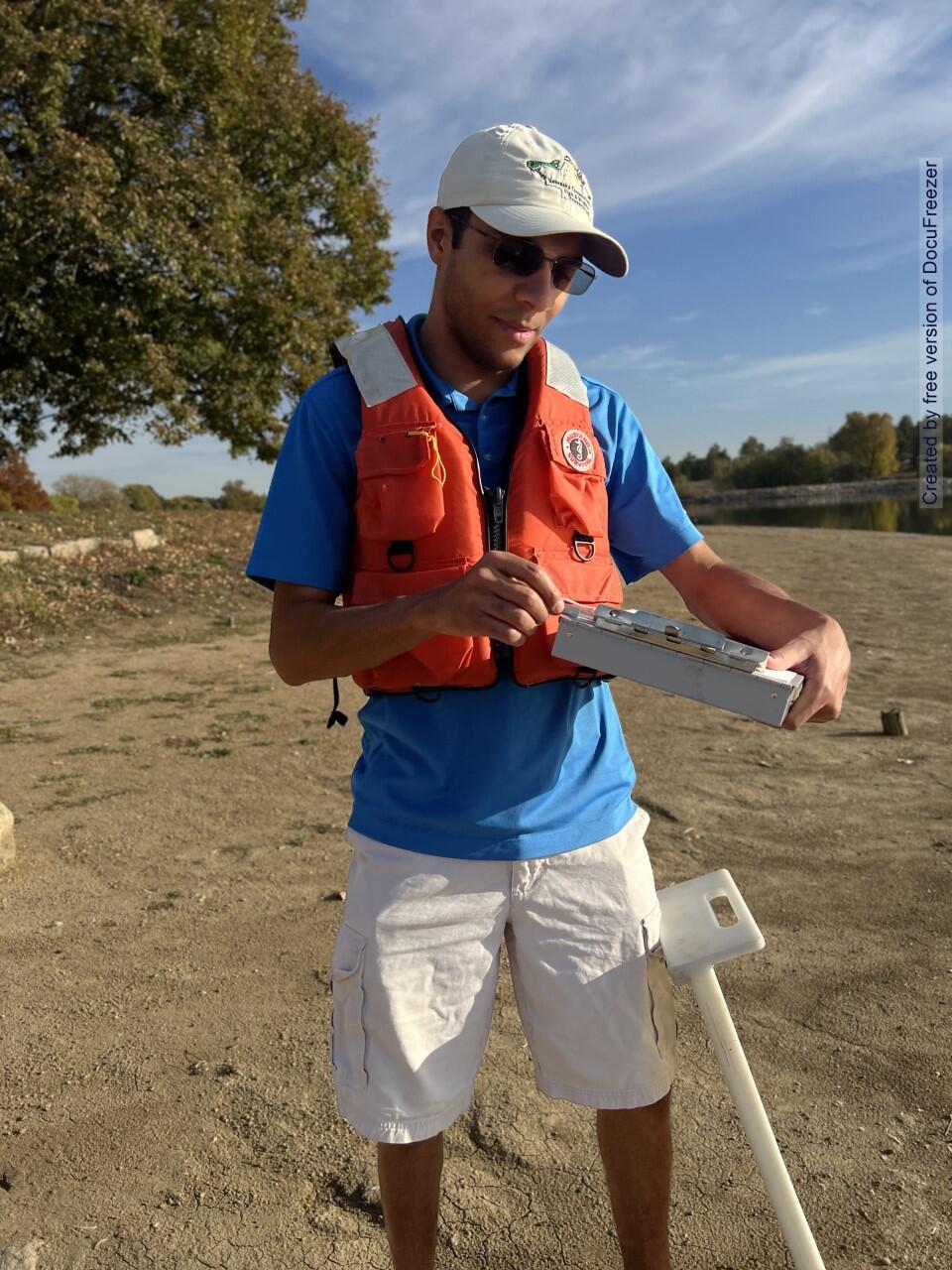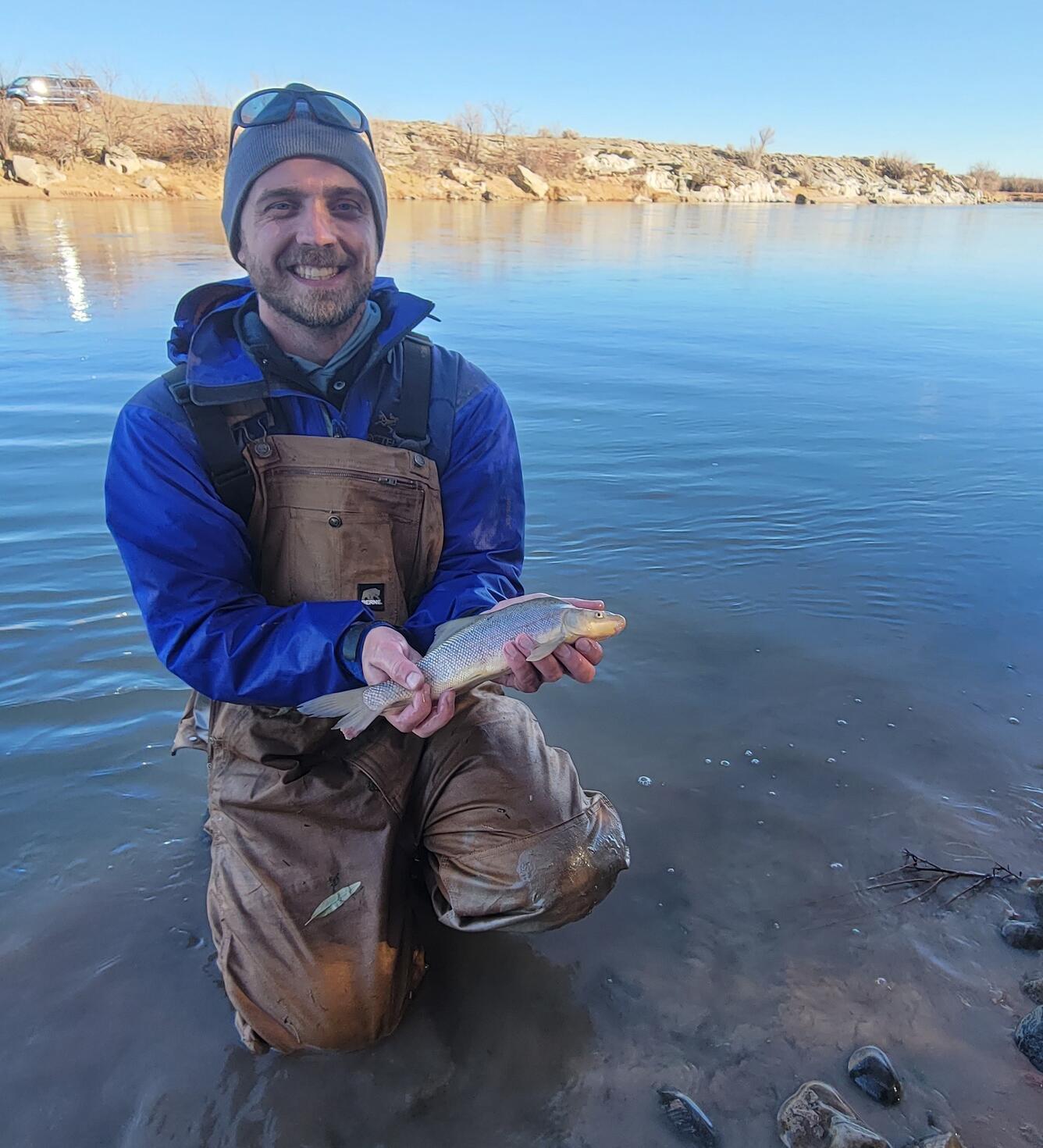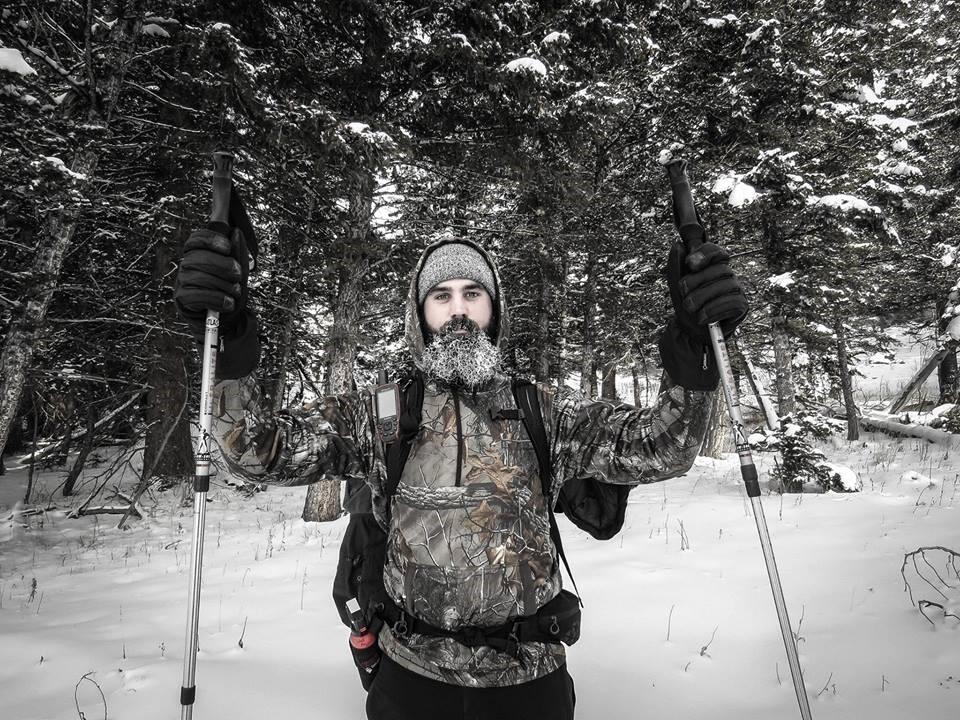Graduate Student Spotlights
People and Wildlife Lab at the University of Washington
Graduate students are the backbone of the CRU program and go on to be leaders in the natural resource profession. Students are advised by unit scientists and conduct research projects that address concerns of our State and Federal cooperators. Students receive academic training from university cooperators. Our spotlights include current and past graduate students and are in no particular order.
Brandon Barlow - University of Nebraska-Lincoln, Nebraska Unit Research Project-Angler behavior in response to management actions on Nebraska reservoirs.
Brandon Barlow is a M.S. student participating in a 15-year research project, administered by the Nebraska Unit, designed to understand behavior patterns of anglers and how their participation is related to fish populations, fish communities and agency management actions. Within this long-term project, Brandon is testing whether the behavior of anglers that reside in an urban environment differs among neighborhoods, and the socioeconomic factors that compose the urban environment. Preliminarily data on angler behaviors differ among neighborhoods, primarily as a function of fish species targeted and the decisions to harvest captured fish. Brandon’s findings will help managers refine management objectives for urban fisheries. Brandon will apply the skills and knowledge from his graduate program as he works toward creating smart water and environmental policy for the benefit of the public. In January 2023, Brandon will begin the prestigious National Sea Grant John A. Knauss Policy Fellowship, a national program that places exceptional early career graduate students with host offices of the Federal government for a 1-year fellowship in Washington, D.C.

Nikola Rodriguez University of Hawaiʻi at Hilo Hawaiʻi Cooperative Fishery Research Unit Research Project: How factors related to climate change and overfishing affect the prevalence of ciguatoxic fishes on Hawaiian coral reefs.
Nikola Rodriguez is an M.S. student with the Hawaiʻi Cooperative Fishery Research Unit and the Tropical Conservation Biology and Environmental Science graduate program at the University of Hawaiʻi at Hilo. She is studying how factors related to climate change and overfishing affect the prevalence of ciguatoxic fishes on Hawaiian coral reefs. Ciguatera fish poisoning is caused by consumption of reef fishes containing toxins produced by dinoflagellates in the genus Gambierdiscus. Gambierdiscus attach to turf algae where herbivorous fishes incidentally consume it while grazing, and the toxins are biomagnified through the food chain. Climate change and alteration of reef fish assemblages through overfishing have the potential to affect the abundance of Gambierdiscus. The project results will help managers protect local communities from ciguatera fish poisoning and allow fishers to adapt their resource use patterns to changing reefscapes.

Benjamin Miller - Utah State University, Utah Unit Research Project: Experimental nonnative wood addition to enhance in-stream habitat for native desert fishes.
Ben Miller is a M.S. student with the Utah Unit at Utah State University, where he is co-advised by Dr. Casey Pennock, Research Faculty in Watershed Sciences and Unit Leader, Dr. Phaedra Budy. Ben developed a strong passion for the conservation of imperiled desert fishes while working as a fish biologist at the Native Fish Lab of Marsh and Associates in Tempe, Arizona. Now, Ben is applying that passion to his graduate research where he is testing the efficacy of adding large woody debris in the form of cut Russian olive (Elaeagnus angustifolia), a nonnative tree, as a means of increasing physical and hydraulic complexity to enhance in-stream habitat for native desert fishes in the San Juan River. The San Juan River, like many other rivers in the Colorado River Basin, is affected by flow regulation, overallocation of water, and establishment of nonnative riparian vegetation, all contributing to broad scale habitat loss and simplification. Ultimately, this project aims to inform managers of the potential for native fish habitat enhancement by exploiting existing and abundant nonnative woody vegetation. Ben and his advisors collaborate with biologists from the BOR, USFWS, Navajo Nation, and other stakeholders of the San Juan River Basin Recovery Implementation Program.

Kearstin Findley University of Arkansas Arkansas Cooperative Fish and Wildlife Research Unit Research Project: Conservation and ecology of the critically endangered, Arkansas endemic yellowcheek darter.
Kearstin Findley obtained a bachelor of science degree in ecology and evolution from Rockford University in her hometown of Rockford, Illinois. During her undergraduate studies, Kearstin was first exposed to working with freshwater fishes during a research experience at Ohio State University. This experience working with the USGS on lake trout research led Kearstin to pursue her master of science degree at Southeastern Louisiana University. Kearstin’s thesis was focused on using niche modeling to evaluate the distribution of imperiled freshwater fishes in Louisiana, and she used field surveys to ground truth the models she created. Kearstin’s previous work and interests in freshwater fish conservation led her to pursue a doctor of philosophy degree at the University of Arkansas with the Arkansas Cooperative Fish and Wildlife Research Unit. Her dissertation research is focused on conservation and ecology of the critically endangered, Arkansas endemic yellowcheek darter. Kearstin’s work is in collaboration with the USGS, U.S. Fish and Wildlife Service, Arkansas Game and Fish Commission, and the Arkansas Natural Heritage Commission.

Joshua Vine University of Florida Florida Cooperative Fish and Wildlife Research Unit Research Project: Gulf sturgeon monitoring in the Choctawhatchee River Basin, Florida.
Josh Vine is a Ph.D. student participating in a 4-year monitoring project of Gulf sturgeon populations, focusing on data collection from the Choctawhatchee River Basin. He received his bachelor of science and master of science degrees in wildlife and fisheries biology from Clemson University. Josh is tracking movement of juvenile Gulf sturgeon with acoustic telemetry, where strategically placed stationary telemetry receivers detect fish with implanted sonic tags as they swim past. This passive technique is yielding tens of thousands of detections with minimal effort, and it enables Josh to monitor the spatial and temporal movement of the juveniles in the estuary and river. This research is part of a larger project done in conjunction with the National Oceanic and Atmospheric Administration (NOAA) and the USFWS in Panama City, Florida. The Choctawhatchee River is one of seven freshwater systems, stretching from the Pearl River in Louisiana to the Suwannee River in Florida, under examination in this multistate study. Assessing river-specific population trends with these data may inform restoration strategies.

Ryan Gary, Master of Science Program Oklahoma Cooperative Fish and Wildlife Research Unit - Importance of appropriate spawning substrate as a key driver of paddlefish restoration success in reservoirs of Oklahoma.
Born and raised near the Chesapeake Bay in Maryland, Ryan received his bachelor of science degree from Louisiana State University in Natural Resources Ecology and Management with a concentration in Fisheries Science.
Paddlefish, an important sportfish, have been stocked in reservoirs throughout the State, but these stocking efforts have had variable success. Using side-scan sonar, Ryan is mapping reservoir tributaries and quantifying the amount of suitable spawning substrates to help predict the potential success and efficacy of stocking efforts for establishing self-sustaining populations of paddlefish. Ryan was proud to obtain the In-Memorium Research Award from the North American Sturgeon and Paddlefish Society (NASPS). This award is given to a student who conducts sturgeon and paddlefish research, who demonstrates academic achievement and leadership ability, and whose professional goals support the mission of the NASPS. This award will help fund a paddlefish project to describe the spawning use of the two reservoir tributaries of Keystone Lake, which have differing hydrology and morphology. The Keystone system is notable because it has produced record-size fish, including four State record and two world record paddlefish.

Amelia DuVall Doctor of Philosophy Program Washington Cooperative Fish and Wildlife Research Unit Amelia DuVall is a seabird ecologist and a member of the Quantitative Conversation Lab at the Washington Cooperative Fish and Wildlife Research Unit.
Working closely with the National Park Service, Amelia’s doctoral research project will include seabird population modeling and an assessment of anthropogenic threats at Channel Islands National Park. Specific threats include invasive rodents, which eat seabird eggs, and changing ocean conditions that affect the availability and distribution of prey. The research will provide park managers with a tool to help make informed management and conservation decisions, as well as refine monitoring methods to improve the accuracy and precision of seabird population trends in a cost-effective manner. Amelia achieved two noteworthy accomplishments to facilitate her research: receiving funding from the USGS-National Park Service Natural Resources Preservation Program and receiving her USGS Bird Banding Laboratory master banding permit. Amelia’s fondest memory as a seabird ecologist is of seeing a Scripps’ murrelet chick up close—a rare opportunity, because the chicks head out to sea within 24 to 48 hours of hatching.

Emma Doden Master of Science Program Utah Cooperative Fish and Wildlife Research Unit -- Emma is a second-year graduate student evaluating the efficacy of translocating beavers to desert restoration sites.
Beavers are nature’s ecosystem engineers and may serve as a cost-effective, natural alternative to manmade water restoration projects, especially in arid Western ecosystems. Emma is translocating beavers, which are removed from human conflict situations, to the Price and San Rafael Rivers in eastern Utah to assist with restoration efforts in these degraded desert waterways. The research will facilitate the development of strategies that include beaver assisted restoration and improve understanding of complex issues associated with wildlife translocation. Emma has collaborated with multiple agencies and stakeholders to capture and translocate 30 beavers that would otherwise have been euthanized. Emma is pleased that she, along with the beavers, is assisting in conservation and restoration efforts in a sensitive arid system.

Ben Luukkonen Master of Science Program Iowa Cooperative Fish and Wildlife Research Unit -- Canada Goose-Human Conflicts
Ben Luukkonen grew up hunting, fishing, and spending time outdoors and dreams of having a career where he can promote and inform sciencebased wildlife management and conservation. Ben is particularly interested in waterfowl ecology and management, and his research focuses on movement and survival of Canada geese in urban and rural areas of Iowa. In cooperation with the Iowa Department of Natural Resources, Ben is marking geese with global positioning system transmitters and analyzing banding data to learn what role waterfowl hunters can play in helping to reduce increasing human-goose conflicts. The research will help to develop strategies to improve goose management in urban areas through a balance between maximizing recreational hunting opportunities and minimizing conflicts. Ben received funding awards through the Department of Natural Resource Ecology and Management at Iowa State University and the Washington Brant Foundation for his work. Ben is thankful for the partnership and commitment he had from the Iowa Department of Natural Resources, as their joint efforts will directly inform management to benefit Canada geese and humans alike.

Josh Blouin Master of Science Program Vermont Cooperative Fish and Wildlife Research Unit Josh Blouin is an avid wildlife photographer who loves to travel around the State to photograph Vermont’s wildlife and beautiful landscapes.
Josh graduated with a bachelor of science degree in wildlife biology from the University of Vermont in 2015. Since then, Josh has worked on various wildlife research projects, including studies of Kodiak brown bears in Alaska, wolves in Yellowstone National Park, wolverines and Canada lynx in northwestern Montana, bats in Yosemite National Park, and black bears in Minnesota. Josh recently returned to the University of Vermont to pursue his master of science degree and is assessing moose habitat suitability in Vermont and how seasonal habitat selection relates to population health. Moose populations in Vermont are in decline, and Josh’s research will provide insights into how habitat management can help reverse the decline and promote the wellbeing of Vermont’s landscape and wildlife. Josh’s passion for wildlife and photography have blended well, as his photographs have been published in various outlets and displayed at several galleries. Notably, one of his photographs was selected by a National Geographic editor as a “Top Photo” during the 2017 nature photographer of the year competition. Josh’s photography is on the front and back cover of this circular.

Lucas Schilder Master of Science Program Texas Cooperative Fish and Wildlife Research Unit Lucas Schilder is originally from Sacramento, California, but received his bachelor of science degree in Natural Resources Management with a concentration in Wildlife Biology from Texas Tech University.
As an undergraduate, Lucas worked on a project quantifying landscape connectivity for lesser prairie-chickens on the Southern High Plains of Texas and New Mexico. Although still involved with that work, Lucas’s master’s degree project is focused on quantifying changes in avian and plant community composition and structure following prescribed thinning of pinyon-juniper woodlands. Climate and land use practices have significantly altered pinyon-juniper woodlands throughout the western United States. To mitigate the changes that have taken place, Federal and State agencies have embraced tree removal and thinning, with the goals of reducing fuel loads and restoring historic stand structure. However, the high proportion of avian pinyon-juniper specialists included on national and State lists of concern has created a need to balance thinning targets with conservation objectives of these woodland-obligate bird species. Lucas’s research will document avian and vegetation community response to thinning and inform conservation strategies designed to benefit multiple species. The project team is also banding juniper titmice to supplement the community analysis by examining the effects of thinning on the survival, site fidelity, and territoriality for this focal species of high conservation concern.

Lara Katz - University of Maine, Maine Unit Research Project: Assessing the distribution and habitat of bridle shiners in Maine.
Lara Katz is a Master of Science (M.S.) student with the Maine Unit and the Department of Wildlife, Fisheries, and Conservation Biology at the University of Maine. Lara was first exposed to fisheries science as an undergraduate, when she spent three summers studying stream recolonization by sea lamprey (Petromyzon marinus) and freshwater fish after dam removal. After her bachelor’s degree, Lara spent 4 years working for Acadia National Park as a wildlife technician and environmental compliance assistant. Lara became interested in monitoring rare species as she researched Acadia’s bat community using acoustics and radio-telemetry. Her interests in rare species monitoring and geographic information systems led her to return to the University of Maine to pursue her Master’s degree. Her thesis research focuses on locating remnant populations of the bridle shiner, a rare native minnow, in southern and western Maine. She is using a combination of seine netting and eDNA sampling to locate the fish. Lara is also developing a predictive habitat model to help inform future surveys, long-term monitoring, and conservation actions. Her research is supported by, and in collaboration with, the USGS, Maine Department of Inland Fisheries and Wildlife, and the Maine Outdoor Heritage Fund.


